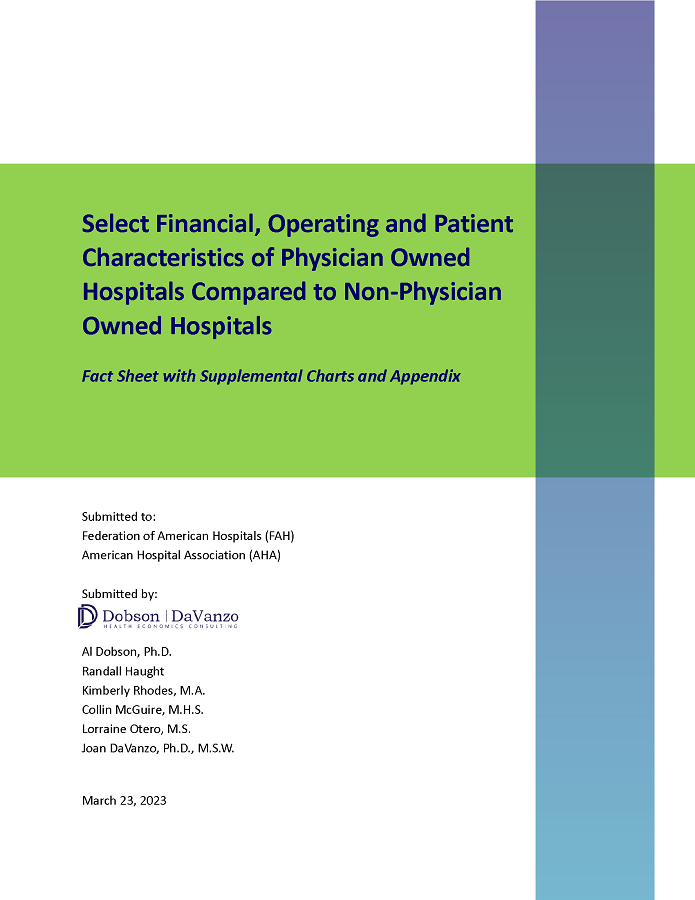

Select Financial, Operating and Patient Characteristics of POHs Compared to Non-POHs Fact Sheet
Select Financial, Operating and Patient Characteristics of Physician Owned Hospitals Compared to Non-Physician Owned Hospitals Fact Sheet with Supplemental Charts and Appendix
Submitted to:
Federation of American Hospitals (FAH)
American Hospital Association (AHA)
Submitted by:

Al Dobson, Ph.D.
Randall Haught
Kimberly Rhodes, M.A.
Collin McGuire, M.H.S.
Lorraine Otero, M.S.
Joan DaVanzo, Ph.D., M.S.W.
March 23, 2023
Fact Sheet
Dobson | DaVanzo recently examined select operating, financial and patient characteristics of hospitals in categories defined by hospital ownership.1 This fact sheet provides descriptive statistics for physician owned hospitals (POHs) compared to non-physician owned hospitals. Exhibit 1 provides these statistics in tabular form, while Figures 1 through 12 present the data graphically.
The POHs represented in this fact sheet were identified based primarily on a June 2016 Physician Hospitals of America list and subsequent FAH/AHA review. Non-POHs are defined as the remaining acute care hospitals that are paid under the inpatient hospital prospective payment system (IPPS) defined under Section 1886(d) of the Social Security Act.2 Using the FY 2023 Hospital IPPS Final Rule and Correction Notice Impact Public Use File and FY 2020-2021 Medicare Cost Reports, we identified 163 POHs and 3,020 non-POHs for inclusion in the analysis.3
The data were drawn from the FY 2020-2021 Medicare Cost Reports,4 the FY 2023 Hospital IPPS Final Rule and Correction Notice Impact Public Use File, the FY 2022 CMS 100% Research Identifiable (RIF) File Fee-For-Service (FFS) claims and Master Beneficiary Summary File (MBSF) data for inpatient and outpatient services. Specific data sources for each variable are provided in the Appendix.
The statistics included in Exhibit 1 and Figures 1 through 12 show the differences in select hospital operating, financial and patient characteristics between POHs and non-POHs. Overall, these data indicate that compared to non-POHs, POHs generally treat a population that is younger, less complex or comorbid, and less likely to be dually eligible or non-white, and that POHs have higher margins and lower unreimbursed and uncompensated care costs as a percent of net patient revenue compared to non-POHs. Specifically, POHs had: 1) lower Medicaid discharges as percent of total discharges, 2) lower percent of Medicare inpatient claims with Emergency Room services, 3) lower percent of Medicare inpatient claims for patients with dual eligibility, 4) lower percent of Medicare inpatient claims for patients aged 85 years or older, 5) lower percent of Medicare inpatient claims for non-white patients, 6) lower percent of Medicare discharges for patients with a primary or secondary diagnosis of COVID-19, and 7) lower mean number of CC/MCCs5 per Medicare claim when compared to non-POHs.
POHs also had: 1) a lower percentage of hospitals located in rural areas, 2) a higher percentage of hospitals with Medicare maximum readmission penalty of 3%, 3) higher patient care and overall Medicare margins, and 4) lower unreimbursed and uncompensated care costs as a percent of net patient revenue than non-POHs. While not shown, additional analyses of FY 2018-2020 Medicare Cost Reports and FY 2019-2021 Medicare claims data indicate similar patterns and consistency in the differences between POHs and non-POHs over time.
| POHs | Non-POHs | |
|---|---|---|
| Number of Hospitals | 163 | 3,020 |
|
|
||
| Percentage of Hospitals with Medicare Maximum Readmission Penalty of 3% | 5.6% | 1.0% |
| Percentage of Hospitals Located in Rural Areas | 6.8% | 24.0% |
| Patient Care Margin6 | 15.3% | -1.4% |
| Overall Medicare Margin6 | -0.3% | -8.3% |
| Total Unreimbursed and Uncompensated Care Cost as a Percent of Net Patient Revenue7 | 3.1% | 6.7% |
|
|
||
| Medicaid Discharges as a Percent of Total | 3.5% | 8.4% |
| Medicaid Discharges as a Percent of Total | 3.5% | 8.4% |
| Percentage of Medicare Inpatient Claims with Emergency Room Services | 39.1% | 79.0% |
| Percentage of Medicare Inpatient Claims for Patients with Dual Eligibility | 15.6% | 26.3% |
| Mean Number of CC/MCCs per Medicare Claim | 2.3 | 3.7 |
| Percentages of Medicare Inpatient Claims for Patients who are 85 Years or Older | 12.1% | 19.7% |
| Percentage of Medicare Inpatient Claims for Patients who are Non-White | 17.5% | 22.3% |
| Percentage of Medicare Inpatient Claims for Patients with a Diagnosis of COVID-19 (Primary or Secondary) | 4.1% | 8.6% |
Source: Dobson | DaVanzo analysis of FY 2020-2021 Medicare Hospital Cost Report data, FY 2022 Medicare RIF claims data, MBSF data, and FY 2023 Medicare IPPS Impact File data.
- This study was commissioned by the Federation of American Hospitals (FAH) and the American Hospital Association (AHA).
- Critical Access Hospitals (small rural hospitals), Psychiatric Hospitals, Inpatient Rehabilitation Facilities, Long Term Care Hospitals, and Pediatric Hospitals are excluded.
- Note that the number of hospitals included can vary by metric, based on the available data; please refer to the Appendix for details.
- Medicare Cost Reports data for FY 2021 is incomplete, for missing hospitals we used their FY 2020 cost report.
- CC is defined as complicating or comorbid condition. MCC is defined as a major complicating or comorbid condition.
- Margins are calculated as aggregate revenues minus aggregate costs, divided by aggregate revenues across all hospitals in the group.
- Unreimbursed and uncompensated care costs are defined as Line 31 from the Worksheet S-10, which includes the total unreimbursed cost for Medicaid, CHIP, and state and local indigent care programs, the cost of charity care, and the cost of non-Medicare and non-reimbursable Medi-care bad debt expense. This metric is calculated as aggregate Unreimbursed and Uncompensated Care Costs divided by net patient revenue across all hospitals in the group.
- Data represent weighted averages across providers in the group using number of discharges.


